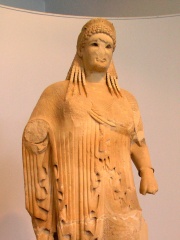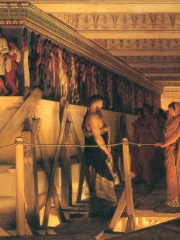
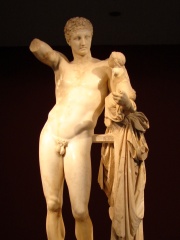
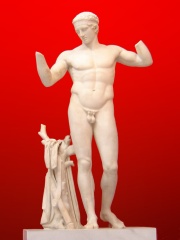
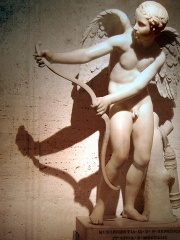
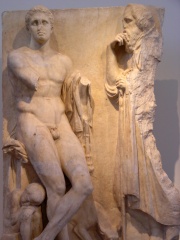

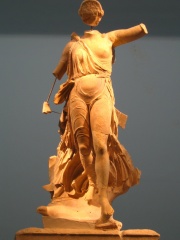
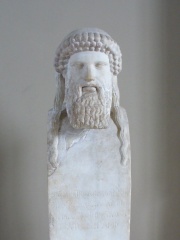
The Most Famous
SCULPTORS from Greece
This page contains a list of the greatest Greek Sculptors. The pantheon dataset contains 258 Sculptors, 18 of which were born in Greece. This makes Greece the birth place of the 5th most number of Sculptors behind United States, and Germany.
Top 10
The following people are considered by Pantheon to be the top 10 most legendary Greek Sculptors of all time. This list of famous Greek Sculptors is sorted by HPI (Historical Popularity Index), a metric that aggregates information on a biography's online popularity. Visit the rankings page to view the entire list of Greek Sculptors.

1. Phidias (490 BC - 430 BC)
With an HPI of 82.85, Phidias is the most famous Greek Sculptor. His biography has been translated into 68 different languages on wikipedia.
Phidias or Pheidias (; Ancient Greek: Φειδίας, Pheidias; c. 480 – c. 430 BC) was an Ancient Greek sculptor, painter, and architect, active in the 5th century BC. His Statue of Zeus at Olympia was one of the Seven Wonders of the Ancient World. Phidias also designed the statues of the goddess Athena on the Athenian Acropolis, namely the Athena Parthenos inside the Parthenon, and the Athena Promachos, a colossal bronze which stood between it and the Propylaea, a monumental gateway that served as the entrance to the Acropolis in Athens. Phidias was the son of Charmides of Athens. The ancients believed that his masters were Hegias and Ageladas. Plutarch discusses Phidias's friendship with the Greek statesman Pericles, recording that enemies of Pericles tried to attack him through Phidias – who was accused of stealing gold intended for the Parthenon's statue of Athena, and of impiously portraying himself and Pericles on the shield of the statue. The historical value of this account, as well as the legend about accusations against the 'Periclean circle', is debatable, but Aristophanes mentions an incident with Phidias around that time. Phidias is often credited as the main instigator of the Classical Greek sculptural design. Today, most critics and historians consider him one of the greatest of all ancient Greek sculptors.

2. Praxiteles (395 BC - 330 BC)
With an HPI of 78.31, Praxiteles is the 2nd most famous Greek Sculptor. His biography has been translated into 52 different languages.
Praxiteles (; Greek: Πραξιτέλης) of Athens, the son of Cephisodotus the Elder, was the most renowned of the Attic sculptors of the 4th century BC. He was the first to sculpt the nude female form in a life-size statue. While no indubitably attributable sculpture by Praxiteles is extant, numerous copies of his works have survived; several authors, including Pliny the Elder, wrote of his works; and coins engraved with silhouettes of his various famous statuary types from the period still exist. A supposed relationship between Praxiteles and his beautiful model, the Thespian courtesan Phryne, has inspired speculation and interpretation in works of art ranging from painting (Gérôme) to comic opera (Saint-Saëns) to shadow play (Donnay). Some writers have maintained that there were two sculptors of the name Praxiteles. One was a contemporary of Pheidias, and the other his more celebrated grandson. Though the repetition of the same name in every other generation is common in Greece, there is no certain evidence for either position.

3. Polykleitos (450 BC - 500 BC)
With an HPI of 76.82, Polykleitos is the 3rd most famous Greek Sculptor. His biography has been translated into 46 different languages.
Polykleitos (; Ancient Greek: Πολύκλειτος) was an ancient Greek sculptor, active in the 5th century BCE. Alongside the Athenian sculptors Pheidias, Myron and Praxiteles, he is considered as one of the most important sculptors of classical antiquity. The 4th century BCE catalogue attributed to Xenocrates (the "Xenocratic catalogue"), which was Pliny's guide in matters of art, ranked him between Pheidias and Myron. He is particularly known for his lost treatise, the Canon of Polykleitos (a canon of body proportions), which set out his mathematical basis of an idealised male body shape. None of his original sculptures are known to survive, but many marble works, mostly Roman, are believed to be later copies.

4. Lysippos (390 BC - 300 BC)
With an HPI of 75.87, Lysippos is the 4th most famous Greek Sculptor. His biography has been translated into 49 different languages.
Lysippos (; Ancient Greek: Λύσιππος) was a Greek sculptor of the 4th century BC. Together with Scopas and Praxiteles, he is considered one of the three greatest sculptors of the Classical Greek era, bringing transition into the Hellenistic period. Problems confront the study of Lysippos because of the difficulty in identifying his style in the copies which survive. Not only did he have a large workshop and many disciples in his immediate circle, but there is understood to have been a market for replicas of his work, supplied from outside his circle, both in his lifetime and later in the Hellenistic and Roman periods. The Victorious Youth or Getty bronze, which resurfaced around 1972, has been associated with him.
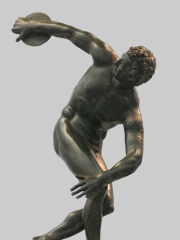
5. Myron (500 BC - 500 BC)
With an HPI of 74.09, Myron is the 5th most famous Greek Sculptor. His biography has been translated into 49 different languages.
Myron of Eleutherae (; Ancient Greek: Μύρων, Myrōn [mý.rɔːn]; c. 485 – c. 440 BC) was an Athenian sculptor from the mid-5th century BC. Alongside three other Greek sculptors, Polykleitos, Pheidias, and Praxiteles, Myron is considered as one of the most important sculptors of classical antiquity. He was born in Eleutherae on the borders of Boeotia and Attica. According to Natural History, a Latin encyclopedia by Pliny the Elder (AD 23–79), a scholar in Ancient Rome, Ageladas of Argos was his teacher. None of his original sculptures are known to survive, but there are many later copies of his works, such as his Discobolus, mostly Roman.

6. Scopas (395 BC - 350 BC)
With an HPI of 72.92, Scopas is the 6th most famous Greek Sculptor. His biography has been translated into 36 different languages.
Scopas (Ancient Greek: Σκόπας; born in Paros, fl. 4th century BC) was an ancient Greek sculptor and architect, most famous for his statue of Meleager, the copper statue of Aphrodite, and the head of goddess Hygieia, daughter of Asclepius.

7. Leochares (400 BC - 400 BC)
With an HPI of 68.77, Leochares is the 7th most famous Greek Sculptor. His biography has been translated into 32 different languages.
Leochares (Greek: Λεοχάρης or Λεωχάρης) was an ancient Greek sculptor from Athens, who lived in the 4th century BC.

8. Paeonius (500 BC - 460 BC)
With an HPI of 66.77, Paeonius is the 8th most famous Greek Sculptor. His biography has been translated into 20 different languages.
Paionios (Ancient Greek: Παιώνιος Paiṓnios) of Mende, Chalkidiki was a Greek sculptor of the late 5th century BC. He most likely received his early training in Northern Greece and is thought to have later adapted Athenian stylistic elements into his own work, based upon his probable interaction with the Olympia workshop of Phidias. In any case, he was "Attic-trained." Paionios won the commission to decorate the acroteria of the Temple of Zeus at Olympia, as described in the pedestal inscription on his Nike statue. An ancient account also references Paionios' work at Olympia. Pausanias attributes the front (east) pedimental sculptures of the Temple of Olympian Zeus to Paionios. The Nike Temple parapet at Athens is also often attributed to Paionios, on the basis of similarities between the styles of drapery on both monuments. Despite this assertion, scholars continue to debate the reliability of these attributions based upon the various interpretations of the scant additional evidence. The Nike of Paionios featured prominently in the design of medals of the 2004 Summer Olympics in Athens, as it did in the design of medals from succeeding Olympiads. The statue likely influenced later artistic renderings of victory personified. It is on permanent exhibition at the Archaeological Museum of Olympia.

9. Alcamenes (500 BC - 400 BC)
With an HPI of 66.62, Alcamenes is the 9th most famous Greek Sculptor. His biography has been translated into 26 different languages.
Alcamenes (Ancient Greek: Ἀλκαμένης) was an ancient Greek sculptor of Lemnos and Athens, who flourished in the 2nd half of the 5th century BC. He was a younger contemporary of Phidias and noted for the delicacy and finish of his works, among which a Hephaestus and an Aphrodite of the Gardens were conspicuous. Pausanias says that he was the author of one of the pediments of the temple of Zeus at Olympia, but this seems a chronological and stylistic impossibility. Pausanias also refers to a statue of Ares by Alcamenes that was erected on the Athenian agora, which some have related to the Ares Borghese. However, the temple of Ares to which he refers had only been moved from Acharnes and re-sited in the Agora in Augustus's time, and statues known to derive from Alcamenes' statue show the god in a breastplate, so the identification of Alcamenes' Ares with the Ares Borghese is not secure. At Pergamum there was discovered in 1903 a Hellenistic copy of the head of the Hermes "Propylaeus" of Alcamenes. As, however, the deity is represented in a Neo-Attic, archaistic and conventional character, this copy cannot be relied on as giving us much information as to the usual style of Alcamenes, who was almost certainly a progressive and original artist. It is safer to judge him by the sculptural decoration of the Parthenon, in which he must almost certainly have taken a share under the direction of Phidias. He is said to be the most eminent sculptor in Athens after the departure of Phidias for Olympia, but enigmatic in that none of the sculptures associated with his name in classical literature can be securely connected with existing copies.
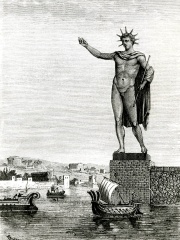
10. Chares of Lindos (400 BC - 280 BC)
With an HPI of 66.58, Chares of Lindos is the 10th most famous Greek Sculptor. His biography has been translated into 20 different languages.
Chares of Lindos (; Ancient Greek: Χάρης ὁ Λίνδιος, gen.: Χάρητος; before 305 BC – c.280 BC) was a Greek sculptor born on the island of Rhodes. He was a pupil of Lysippos. Chares constructed the Colossus of Rhodes in 282 BC, an enormous bronze statue of the sun god Helios and the patron god of Rhodes. The statue was built to commemorate Rhodes' victory over the invading Macedonians in 305 BC, led by Demetrius I, son of Antigonus, a general under Alexander the Great. Also attributed to Chares was a colossal head that was brought to Rome and dedicated by P. Lentulus Spinther on the Capitoline Hill in 57 BC (Pliny, Natural History XXXIV.18). The Colossus of Rhodes is one of the Seven Wonders of the Ancient World, and was considered Chares's greatest accomplishment, until its destruction in an earthquake in 226 BC. The work may have been completed by Laches, also an inhabitant of Lindos.
People
Pantheon has 18 people classified as Greek sculptors born between 600 BC and 0. Of these 18, none of them are still alive today. The most famous deceased Greek sculptors include Phidias, Praxiteles, and Polykleitos.
Deceased Greek Sculptors
Go to all RankingsPhidias
490 BC - 430 BC
HPI: 82.85
Praxiteles
395 BC - 330 BC
HPI: 78.31
Polykleitos
450 BC - 500 BC
HPI: 76.82
Lysippos
390 BC - 300 BC
HPI: 75.87
Myron
500 BC - 500 BC
HPI: 74.09
Scopas
395 BC - 350 BC
HPI: 72.92
Leochares
400 BC - 400 BC
HPI: 68.77
Paeonius
500 BC - 460 BC
HPI: 66.77
Alcamenes
500 BC - 400 BC
HPI: 66.62
Chares of Lindos
400 BC - 280 BC
HPI: 66.58
Ageladas
600 BC - 500 BC
HPI: 65.98
Antenor
590 BC - 500 BC
HPI: 64.37


